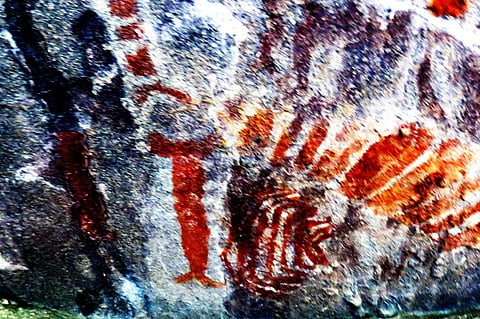

In a rare discovery, historians have uncovered rock art that is believed to have originated in the Paleolithic age in Telangana's Nallamudi in Jagannadhapuram of Bhadradri-Kothagudem district.
The art pieces were found at the feet of Ontigundu in the lime-stone hills near a place of worship of the Naikpods, an Adivasi community. Members of the team included the Telangana Jagruthi history wing, Rock Art Society of India (RASI), rock art enthusiast Kondaveeti Gopi and scientist K Gnaneshwar.
Raman Spectroscopy examination was used to determine and confirm that the rock art at Ontigundi, close to Nallamudi village, was prehistoric. Stone tools from a similar period were also found at the site. Raman Spectroscopy is a technique used to identify the age of materials that are thousands of years old.

It was local history enthusiast Kondaveeti Gopi who first came across the Ontigundu site during his visit to another rock art site, Aksharaloddi, which is in the same vicinity. Locals in the area had informed him that there was a similar site nearby.
The two-day exploration of the site by the team also unearthed wooden fossils, which is around 6.5 crore years old, in nearby Aksharaloddi, another site where rock art was found in July 2019. The discovery of wooden fossils raises the possibility of finding dinosaur fossils.
According to Sriramoju Haragopal of the Telangana Jagruti history wing, five stone bars found were once "worshiped as Pandavas" by Nayakpods (native tribes) while another half-sculpted rock features a head with a moustache. At another hilltop, an eight-foot stone pole was found with the image of a goddess carved in it.
Haragopal added, "There is a rock art that shows snakes, monitor lizards, flower designs, rectangular unknown paintings as well as the sun along with anthropomorphic (human-like) paintings.”
.jpg?w=640&auto=format%2Ccompress)
According to history enthusiasts, the site also has certain rock art with white coloured-edges.
Haragopal said that though rock art forms found recently across Telangana are similar to the latest findings, the Ontigundu findings hail from mid-Paleolithic age to late-upper Paleolithic age.
It was noted that micro-tools such as blades and thin-swords were also found at the foot of the hill. These micro-tools are similar ones recently found in Neeladri (Ramachandrapuram) and Rachakonda.
.jpg?w=640&auto=format%2Ccompress)
However, Sriramoju Haragopal and Katta Srinivas of Telangana Jagruti History wing said that climate change and human movement on the premises was ruining the rock art form. They advocated for the preservation of the site through an iron square frame. "If we don't take action to preserve this rich heritage, the Ontigundu-Aksharaloddi twin sites of rock art forms will become faded memories," they said.
According to history enthusiasts, the site also has certain rock art with white coloured-edges.
Haragopal said that though rock art forms found recently across Telangana are similar to the latest findings, the Ontigundu findings hail from mid-Paleolithic age to late-upper Paleolithic age.